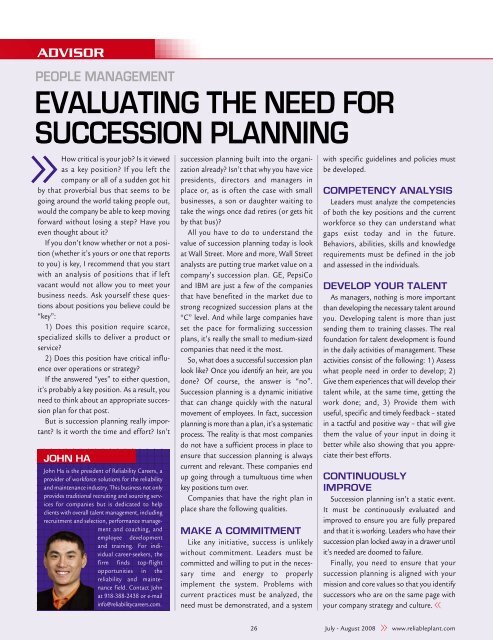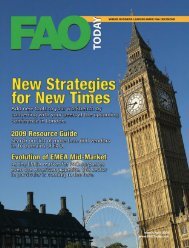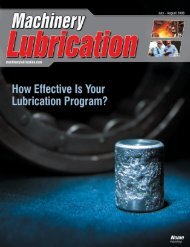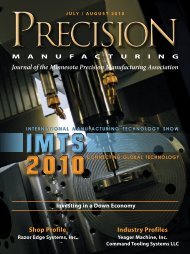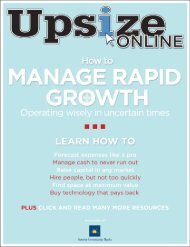Reliable Plant July August 2008
Reliable Plant July August 2008
Reliable Plant July August 2008
You also want an ePaper? Increase the reach of your titles
YUMPU automatically turns print PDFs into web optimized ePapers that Google loves.
ADVISOR<br />
PEOPLE MANAGEMENT<br />
EVALUATING THE NEED FOR<br />
SUCCESSION PLANNING<br />
How critical is your job? Is it viewed<br />
as a key position? If you left the<br />
company or all of a sudden got hit<br />
by that proverbial bus that seems to be<br />
going around the world taking people out,<br />
would the company be able to keep moving<br />
forward without losing a step? Have you<br />
even thought about it?<br />
If you don’t know whether or not a position<br />
(whether it’s yours or one that reports<br />
to you) is key, I recommend that you start<br />
with an analysis of positions that if left<br />
vacant would not allow you to meet your<br />
business needs. Ask yourself these questions<br />
about positions you believe could be<br />
“key”:<br />
1) Does this position require scarce,<br />
specialized skills to deliver a product or<br />
service?<br />
2) Does this position have critical influence<br />
over operations or strategy?<br />
If the answered “yes” to either question,<br />
it’s probably a key position. As a result, you<br />
need to think about an appropriate succession<br />
plan for that post.<br />
But is succession planning really important?<br />
Is it worth the time and effort? Isn’t<br />
JOHN HA<br />
John Ha is the president of Reliability Careers, a<br />
provider of workforce solutions for the reliability<br />
and maintenance industry. This business not only<br />
provides traditional recruiting and sourcing services<br />
for companies but is dedicated to help<br />
clients with overall talent management, including<br />
recruitment and selection, performance management<br />
and coaching, and<br />
employee development<br />
and training. For individual<br />
career-seekers, the<br />
firm finds top-flight<br />
opportunities in the<br />
reliability and maintenance<br />
field. Contact John<br />
at 918-388-2438 or e-mail<br />
info@reliabilitycareers.com.<br />
succession planning built into the organization<br />
already? Isn’t that why you have vice<br />
presidents, directors and managers in<br />
place or, as is often the case with small<br />
businesses, a son or daughter waiting to<br />
take the wings once dad retires (or gets hit<br />
by that bus)?<br />
All you have to do to understand the<br />
value of succession planning today is look<br />
at Wall Street. More and more, Wall Street<br />
analysts are putting true market value on a<br />
company’s succession plan. GE, PepsiCo<br />
and IBM are just a few of the companies<br />
that have benefited in the market due to<br />
strong recognized succession plans at the<br />
“C” level. And while large companies have<br />
set the pace for formalizing succession<br />
plans, it’s really the small to medium-sized<br />
companies that need it the most.<br />
So, what does a successful succession plan<br />
look like? Once you identify an heir, are you<br />
done? Of course, the answer is “no”.<br />
Succession planning is a dynamic initiative<br />
that can change quickly with the natural<br />
movement of employees. In fact, succession<br />
planning is more than a plan, it’s a systematic<br />
process. The reality is that most companies<br />
do not have a sufficient process in place to<br />
ensure that succession planning is always<br />
current and relevant. These companies end<br />
up going through a tumultuous time when<br />
key positions turn over.<br />
Companies that have the right plan in<br />
place share the following qualities.<br />
MAKE A COMMITMENT<br />
Like any initiative, success is unlikely<br />
without commitment. Leaders must be<br />
committed and willing to put in the necessary<br />
time and energy to properly<br />
implement the system. Problems with<br />
current practices must be analyzed, the<br />
need must be demonstrated, and a system<br />
with specific guidelines and policies must<br />
be developed.<br />
COMPETENCY ANALYSIS<br />
Leaders must analyze the competencies<br />
of both the key positions and the current<br />
workforce so they can understand what<br />
gaps exist today and in the future.<br />
Behaviors, abilities, skills and knowledge<br />
requirements must be defined in the job<br />
and assessed in the individuals.<br />
DEVELOP YOUR TALENT<br />
As managers, nothing is more important<br />
than developing the necessary talent around<br />
you. Developing talent is more than just<br />
sending them to training classes. The real<br />
foundation for talent development is found<br />
in the daily activities of management. These<br />
activities consist of the following: 1) Assess<br />
what people need in order to develop; 2)<br />
Give them experiences that will develop their<br />
talent while, at the same time, getting the<br />
work done; and, 3) Provide them with<br />
useful, specific and timely feedback – stated<br />
in a tactful and positive way – that will give<br />
them the value of your input in doing it<br />
better while also showing that you appreciate<br />
their best efforts.<br />
CONTINUOUSLY<br />
IMPROVE<br />
Succession planning isn’t a static event.<br />
It must be continuously evaluated and<br />
improved to ensure you are fully prepared<br />
and that it is working. Leaders who have their<br />
succession plan locked away in a drawer until<br />
it’s needed are doomed to failure.<br />
Finally, you need to ensure that your<br />
succession planning is aligned with your<br />
mission and core values so that you identify<br />
successors who are on the same page with<br />
your company strategy and culture.<br />
26 <strong>July</strong> - <strong>August</strong> <strong>2008</strong> www.reliableplant.com


